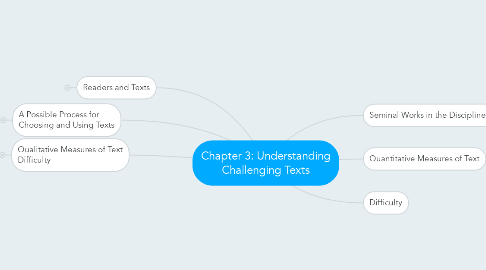Chapter 3: Understanding Challenging Texts
by Trenton Tate


1. Qualitative Measures of Text Difficulty
1.1. There is more to text difficulty than what can be counted electronically.
1.2. Must be mindful that what makes a text difficult for nonnative speakers of English might be different than what makes it difficult for native speakers.
1.3. Qualitative analysis of text difficulty is specifically described in the CCSS (Appendix A) as a process that can be accomplished only by a mature and informed reader - not by a computer.
1.4. Teachers of English, with their specialized knowledge of literature, are in the best position to conduct qualitative analyses of literary texts.
1.5. Teachers in other subjects areas will also have to become expert at analyzing the texts that they use.
1.6. When we begin planning CCSS lessons, we have to engage in multiple readings of the same text for different purposes. These are to consider the levels of meaning, purpose, text structure, visual representations, language demands, and knowledge demands.
2. Readers and Texts
2.1. Quantitative and qualitative analyses make no sense without knowledge of what particular students know and can do. In addition, it doesn't make sense to know how difficult a text is in the abstract; we have to know how difficult it is for a specific reader.
2.2. Reader considerations go beyond knowledge and skill levels to include social and emotional development.
3. A Possible Process for Choosing and Using Texts
3.1. First, work schoolwide. To truly enact the CCSS in middle schools and high schools will require the full participation of every teacher in every discipline.
3.2. Second, read Appendix B of CCSS in full and ensure that at least one of the exemplars listed there is used in each discipline at each grade level.
3.3. Third, use the text recommendations as an estimate of the distance between the CCSS and current practice. When specific sections are already in use at the grade level recommended, discuss student work with those texts.
3.4. Fourth, do not ignore the quantitative measures of text difficulty. Use your current grading period structure as a guide. As you choose texts, make sure that during each grading period students read at least one full-length text in each discipline within the quantitative band for that grade level.
3.5. Fifth, do not forgo traditional textbooks and informational articles, especially in science and social studies.
3.6. Finally, use qualitative analysis of text difficulty as the foundation of instructional planning.
3.6.1. Read for Content: What can students learn from this text?
3.6.2. Read for Structure: How has the author structured the presentation?
3.6.3. Read for Knowledge: What does the author think my students already know?
4. Seminal Works in the Disciplines
4.1. CCSS takes a planned backwards approach to deal with the demand to read difficult texts independently, in college, and introduces more challenging texts in K-12.
4.2. Appendix A defines attention to text complexity as one of the requirements of the standards.
4.3. After considering issues of text complexity, quality, and range, the standards work group chose a set of exemplar texts as illustrations and listed and/or excerpted them in Appendix B.
4.4. In primary grades, stories, poetry and informational texts are read by students and also aloud to them.
4.5. Beginning in middle school, drama is added to narratives, and informational texts are included in three more specific lists: ELA, history and social science, and science, math and technical subjects.
5. Quantitative Measures of Text
5.1. Key component to any approach to curriculum is vertical articulation. (Each successive grade level has to aim for more challenging work.)
5.2. Survey of educational leaders showed that more than half believe the new standards are more rigorous that the standards that had been used, and not many experience frustration and confusion about how to implement them.
5.3. CCSS has set new Lexile standards, which raise the expected ranges for each grade. For example, the previous range for grades 9 and 10, is now the range for grades 6-8.
5.3.1. Lexiles are numbers derived from a formula that considers sentence length and word frequency. A higher Lexile number, indicates a greater number of rare words and longer sentences which makes texts more difficult to understand.
